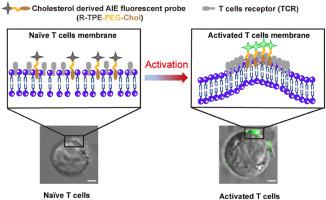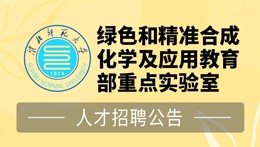European Journal of Medicinal Chemistry ( IF 6.0 ) Pub Date : 2022-12-29 , DOI: 10.1016/j.ejmech.2022.115073
Kaiming Li 1 , Yue Chen 2 , Nianci Zhu 1 , Sijia Chen 1 , Meng Jia 3 , Lingjing Xue 1 , Meixi Hao 1 , Can Zhang 1

|
Successful T-cell based immunotherapy usually depends on the activation of T cells. Most of commonly used methods for assessing T cell activity rely on the antibody-based technology, which focus on detecting protein-centered activation markers, including CD25, cytokines and so on. However, these methods always involve tedious sample-preparation process, labor-consuming and costly, which could not be utilized in real-time detection. The T cell receptor (TCR) clustering is another kind of essential T cell activation marker on the membrane, which increases during the activation state of T cells. We herein developed a cholesterol derived aggregation-induced emission (AIE) fluorescent probe (R-TPE-PEG-Chol) for detecting T cell activation in real-time. Five probes were first designed and synthesized and among them COOH-TPE-PEG-Chol displayed the best imaging effects, which had no significant impact on the key physiological functions of T cells. In addition, we have proved that COOH-TPE-PEG-Chol was introduced onto the naïve T cell membrane in its molecularly dissolved form without fluorescent emission. While during T cell activation, the formation of TCR nanoclusters would induce aggregation of membrane cholesterol, which could provoke the fluorescence signal of the COOH-TPE-PEG-Chol due to the AIE characteristic. Moreover, the enhancement of the fluorescence intensity was positively related to the activation state of T cells. Our study demonstrated the concept of cholesterol-derived AIE fluorescent probes for deciphering the spatiotemporal arrangements of TCR on the membrane during T cell activation, and consequently provided a novel and complementary strategy for detecting T cell activation in real-time.
中文翻译:

通过使用胆固醇衍生的聚集诱导发射探针可视化 TCR 纳米团簇实时检测 T 细胞活化
成功的基于 T 细胞的免疫疗法通常取决于 T 细胞的激活。大多数常用的评估 T 细胞活性的方法依赖于基于抗体的技术,该技术侧重于检测以蛋白质为中心的激活标志物,包括 CD25、细胞因子等。然而,这些方法通常涉及繁琐的样品制备过程,耗费人力且成本高,无法用于实时检测。T 细胞受体 (TCR) 聚集是膜上另一种重要的 T 细胞活化标志物,在 T 细胞活化状态期间会增加。我们在此开发了一种胆固醇衍生的聚集诱导发射 (AIE) 荧光探针 (R-TPE-PEG-Chol),用于实时检测 T 细胞活化。首次设计合成了5种探针,其中COOH-TPE-PEG-Chol成像效果最好,对T细胞的关键生理功能无显着影响。此外,我们已经证明,COOH-TPE-PEG-Chol 以其分子溶解形式被引入到幼稚 T 细胞膜上,没有荧光发射。而在 T 细胞活化过程中,TCR 纳米簇的形成会诱导膜胆固醇聚集,由于 AIE 特性,这可能会激发 COOH-TPE-PEG-Chol 的荧光信号。此外,荧光强度的增强与T细胞的活化状态呈正相关。































 京公网安备 11010802027423号
京公网安备 11010802027423号